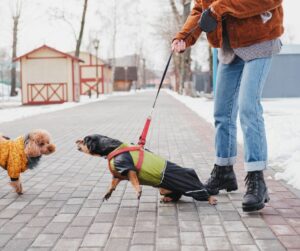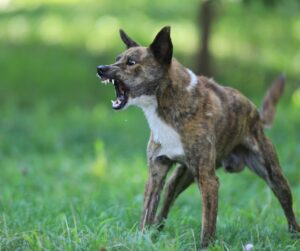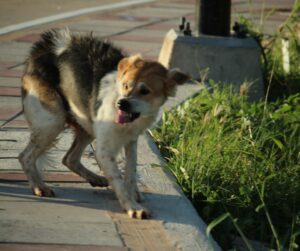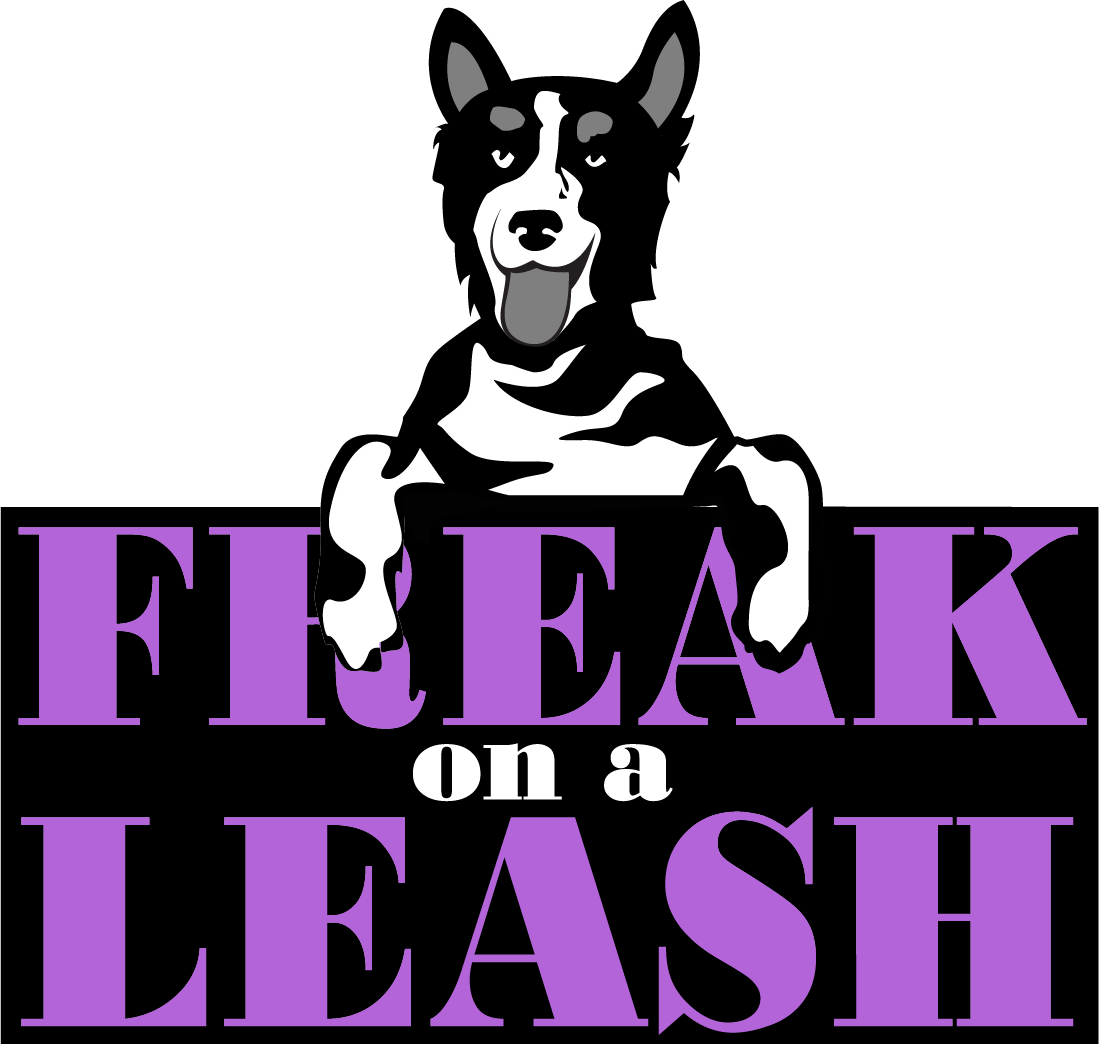Ask any dog owner what behavior they most want to avoid for their pup, and they’re likely to answer aggression. After all, a dog who barks, jumps, or even steals food from the table is nothing compared to a dog who is hostile towards people or other animals.
Dogs who snarl, bite, or angrily attack are usually the least likely to get adopted – and the most likely to be euthanized.
All types of aggression aren’t created equal, however, and the reasons a dog acts aggressive vary. Read on to learn about what can lead to aggression, and how you and your four-legged friend can avoid it.

The Two Types of Aggression
There are two main types of canine aggression: offensive and defensive.
Offensive aggression is, just as it sounds, when your dog is on the offense. They’re in attack mode, ready to pursue whatever is making them upset.
A dog showing offensive aggression will carry his weight on his forelimbs, in the front of his body. His head and neck will be upright, typically locked on whatever stimulus is bothering him.
The tail and hackles will be raised, and the dog will usually be snarling or barking. You may even be able to see his gums and teeth. Dogs in an offensive posture are demonstrating that they’re ready and willing to strike and chase.
Defensive aggression, on the other hand, happens when your dog is in self-protection mode. Dogs on the defensive want to avoid confrontation with whatever is causing them anxiety.
A dog in a defensive posture will have her tail lowered. Her head and neck will also be lower to the ground and might even be turned to the side. Dogs showing defensive aggression will carry their weight over their hind end and might even crouch down to appear smaller.
Defensive dogs will often still snarl and growl, but their ears will be pulled back instead of pointing toward the unwanted stimulus. Dogs in this posture will also freeze or fidget instead of lunging forward.
While both types of aggression can lead to violent, unwanted outcomes, it’s important to identify which is which. After all, a dog shows offensive aggression for completely different reasons than defensive aggression.
Don’t Take Offense!

Dogs go on the offensive when they feel the need to be assertive. They may feel like they need to face off with a predator to protect their territory, their food, their human friends, or even their toys.
Dogs seldom display offensive aggression toward humans on their own. Often when people think that a dog is in attack mode, she’s actually worried and acting out of fear.
Other times, humans unknowingly condition their dog to show offensive aggression. Take a puppy who snaps at his human when they touch him while he’s eating. If the human backs off, the puppy has learned that his behavior succeeded. The next time, if the human doesn’t stop, he may up the ante and try biting instead.
The Line of Defense

Defensive aggression, meanwhile, is often a dog’s last resort when they’re feeling anxious. Dogs on defense are simply hoping to avoid whatever threat they’re perceiving.
Though their behavior might include snarling, snapping, and growling, defensive dogs are ultimately trying to protect themselves and stay out of harm’s way.
Dogs show defensive aggression when they are frightened by an unpleasant stimulus, whether it’s a human, another dog, or even something we know to be harmless, like the vacuum cleaner.
Oftentimes, dogs who have had trauma in their lives respond defensively. If they know they will be punished or will experience pain following a certain stimulus, they’re more likely to try to protect themselves from letting this happen. Dogs with traumatic pasts tend to be wary of potential negative outcomes even in novel situations.
Dogs on defense mode would rather resolve the conflict peacefully than get into a fight – but they’re ready to defend themselves if they have to.
The Easiest Way to Avoid Aggression
While we can’t change the experiences our dogs had before they came to us, we can control the way we train, handle, and reward them in our care. This is a major factor in how calmly our dogs face new or scary situations.
One of the most scientifically proven ways to avoid aggression in your dog is simple: use positive reinforcement instead of positive punishment. This means motivating your dog to do the right thing, rather than adding in a punishment when they do the wrong thing.
Positive reinforcement might mean urging your dog to walk forward with a treat, providing him with a chew toy instead of letting him nip your fingers, or giving praise and pats when he sits down on command. It’s any pleasurable reward offered after a dog acts correctly.
Positive punishment, on the other hand, might look like yanking a choke chain when the dog pauses for too long, spraying water in her face for jumping, or rattling a can of pebbles when she chooses to bark at the wrong time. It’s any unwanted stimulus used to encourage a dog not to repeat a behavior.
Studies Have Shown…
While some trainers swear that aversive stimuli are effective, the proof is in the pudding (or in this case, the scientific papers) that they greatly increase dogs’ stress levels. Take the 2020 study by de Castro et. al. that measured cortisol levels in pups trained with positive punishment versus positive reinforcement.
Cortisol, a steroid hormone, is released in response to stress. Humans release cortisol too – it’s what’s responsible for the shaky hands, pounding heart, and butterflies in your stomach you might feel when confronting a nerve-racking situation.
The de Castro study found that following a training session, dogs exposed to aversive measures displayed ten times the amount of cortisol compared to dogs exposed to positive reinforcement. This significant spike speaks to just how upsetting dogs find those “highly effective” punishments.
Another study compiled by van Herwijnen et. al. in 2021 determined that dogs who were accustomed to aversive training methods interacted less with their owners during play sessions. Perhaps owing to their fear of repercussions, these dogs were more likely to avoid their humans and remain watchfully on guard instead.
In fact, 43% of the owners favoring aversive methods reported that their dogs would growl, snap, lunge, or bite when met with punishments like kicking and hitting. A telling 31% noted similar behaviors when they forced dominance over their dogs by rolling them on their backs or grabbing at the scruffs of their necks.
Clearly, positive punishment opens the door for aggression in dogs. By teaching them to fear the consequences of their behavior, we inadvertently teach them to fear both humans and the unknown… which is enough to put anyone on defense.
Shine a Light on the Good
No dog owner wants to be locked in a vicious cycle in which your dog does something wrong, gets punished, acts aggressive, gets punished, et cetera, et cetera. While you may need to correct your dog for his own safety (or yours!) once in awhile, reinforcing good behavior is an easy way to create a virtuous cycle instead.
Keep training sessions short and happy, making sure to end on a good note without drilling a new skill over and over. Offer your pooch their favorite treat or toy for a job well done, or simply give them a belly rub or a kind word when they’ve done what you want.
These “good choices” don’t have to be monumental, either. Is your dog sitting quietly at your feet while you’re talking to your neighbor? Time for a reward. Is your dog walking at your heels in the park, even though a tempting squirrel just darted past? Give her a treat!
Keep Stress Levels Low
 It’s also important to
It’s also important to
note that some early signs of aggression can be difficult to detect. It may seem like your dog is growling out of nowhere, but you may not have noticed him lowering his head or tail a few moments before.
Growling should never merit a punishment or correction. After all, this is your dog’s nonviolent way of communicating that he doesn’t like whatever unpleasant stimulus is bothering him.
Instead of scolding for a growl, do what you can to eliminate the problem or refocus your dog’s attention. If she learns that merely growling can effectively signal her discomfort, she’ll never feel the need to level up that line of defense to something more violent. Staying in tune with your dog, especially in new or unsettling situations, can help you recognize and diffuse tense situations fast.
Don’t be afraid to call in the professionals if you have an especially difficult pup. It can be hard for our fur babies to unlearn aggressive behavior, and it’s helpful to have an experienced trainer by your side rather than risk anyone getting hurt.
Good training schools like Freak On A Leash can help you transition smoothly to positive reinforcement techniques. They can also provide valuable insight into how to create a less fearful environment for your dog moving forward.
After all, we all know life is better with a dog. Life with a happy dog who doesn’t feel the need to show aggression? That’s the best of all.
If your dog is showing any aggressive behaviors, please reach out to us. We can help!

